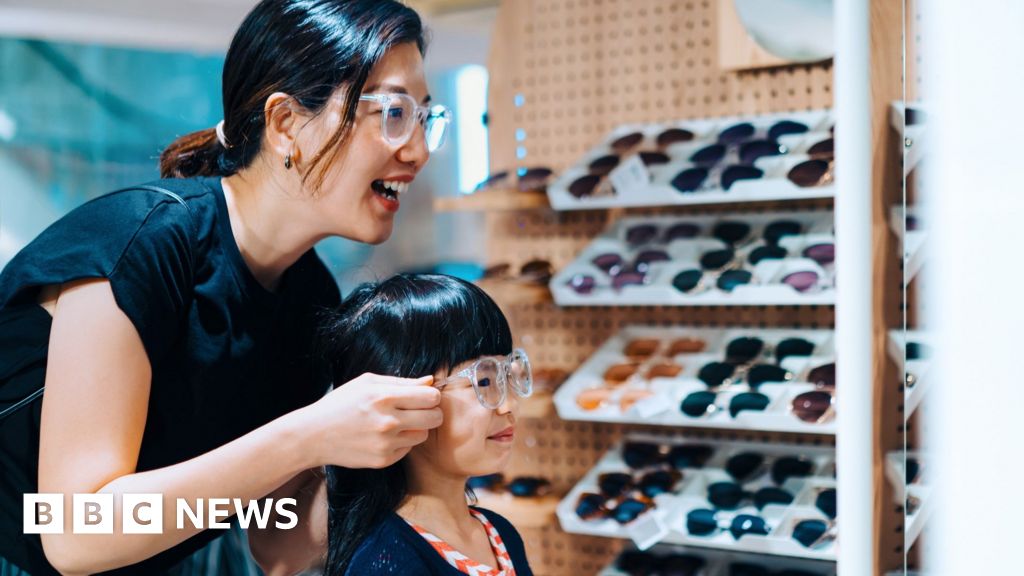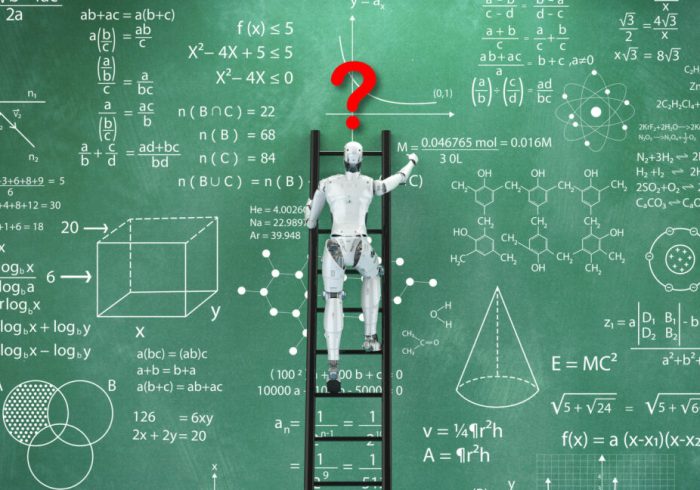Know-how Reporter
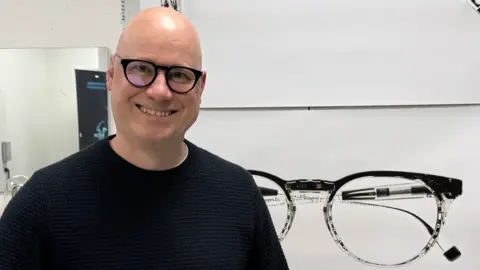 IXI
IXIThey seem like an abnormal pair of glasses – however these are tech-packed specs.
On a Zoom name, Niko Eiden, chief government and co-founder of Finnish eyewear agency IXI, holds up the frames with lenses containing liquid crystals, which means their vision-correcting properties can change on the fly.
This one pair might right the imaginative and prescient of somebody who usually makes use of completely totally different pairs of glasses for seeing close to or far.
“These liquid crystals… we are able to rotate them with {an electrical} area,” explains Mr Eiden.
“It’s very, freely tuneable.” The place of these crystals impacts the passage of sunshine by way of the lenses. A built-in eye-tracker permits the glasses to answer no matter correction the wearer wants at a given second.
Nonetheless, tech-laden eyewear has a troubled historical past – take Google’s ill-fated “Glass” sensible glasses.
Shopper acceptability is vital, acknowledges Mr Eiden. Most individuals do not wish to seem like cyborgs: “We have to make our merchandise truly seem like present eyewear.”
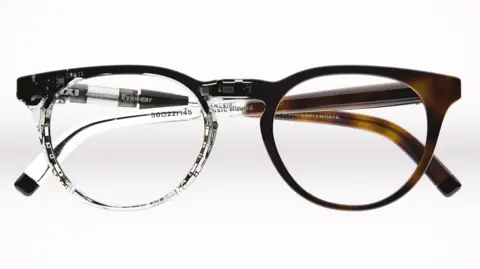 IXI
IXIThe marketplace for eyewear tech is prone to develop.
Presbyopia, an age-related situation that makes it more durable to concentrate on issues near you, is projected to turn into extra widespread over time because the world’s inhabitants ages. And myopia, or short-sightedness, can also be on the rise.
Spectacles have remained largely the identical for many years. Bifocal lenses – by which a lens is cut up into two areas, often for both near- or far-sightedness – require the wearer to direct their imaginative and prescient by way of the related area, relying on what they wish to have a look at, in an effort to see clearly.
Varifocals do an analogous job however the transitions are a lot smoother.
In distinction, auto-focus lenses promise to regulate half or the entire lens spontaneously, and even accommodate the wearer’s altering eyesight over time.
“The primary lenses that we produced had been horrible,” admits Mr Eiden, candidly.
These early prototypes had been “hazy”, he says, and with the lens high quality noticeably poor at its edges.
However newer variations have proved promising in exams, says Mr Eiden. Members within the firm’s trials have been requested, for instance, to learn one thing on a web page, then have a look at an object within the distance, to see whether or not the glasses reply easily to the transition.
Mr Eiden says that the attention monitoring gadget inside the spectacles can not decide precisely what a wearer is , although sure actions akin to studying are in precept detectable due to the character of eye actions related to them.
Since such glasses reply so intently to the wearer’s eye behaviour, it is essential the frames match effectively, says Emilia Helin, product director.
IXI’s frames are adjustable however to not an ideal diploma, given the fragile electronics inside, she explains: “Now we have some flexibility however not full flexibility.” That is why IXI hopes to make sure that the small vary of frames it has designed would go well with all kinds of faces.
The small battery secreted inside IXI’s autofocus frames ought to final for 2 days, says Mr Eiden, including that it is attainable to recharge the specs in a single day whereas the wearer is asleep.
However he will not be drawn on a launch date, which he intends to disclose later this 12 months. As for price, I ask whether or not £1,000 could be the type of price ticket he has in thoughts. He merely says, “I am smiling if you say it however I will not affirm.”
 Getty Pictures
Getty PicturesAutofocus lenses might assist individuals who wrestle with varifocals or bifocals, says Paramdeep Bilkhu, scientific adviser on the School of Optometrists.
Nonetheless, he provides, “There may be inadequate proof to state whether or not they carry out in addition to conventional choices and whether or not they can be utilized for security important duties akin to driving.”
Chi-Ho To, an optometry researcher, on the Hong Kong Polytechnic College has an analogous concern – what if the imaginative and prescient correction went flawed or was delayed barely whereas he was, say, performing surgical procedure on somebody?
“However I feel by way of common use having one thing that enables autofocusing is a good suggestion,” he provides.
Mr Eiden notes that the primary model of his firm’s lenses is not going to alter the whole lens space. “One can at all times look over the dynamic space,” he says. If wholly self-adjusting lenses emerge then security will turn into “a way more severe enterprise”, he provides.
In 2013, UK agency Adlens launched glasses that allowed wearers to manually change the optical energy of the lenses by way of a small dial on the frames. These lenses contained a fluid-filled membrane, which when compressed in response to dial changes would alter its curvature.
Adlens’ present chief government Rob Stevens says the specs offered for $1,250 (£920) within the US and had been “effectively acquired by customers” however not a lot by opticians, which he says “strangled gross sales”.
Since then, expertise has moved on and the idea of lenses that refocus themselves routinely, with out guide interventions, has emerged.
Like IXI and different firms, Adlens is engaged on glasses that do that. Nonetheless, Mr Stevens declines to verify a launch date.
Joshua Silver, an Oxford College physicist, based Adlens however not works for the corporate.
He got here up with the concept of fluid-filled adjustable lenses again in 1985 and developed glasses that could possibly be tuned to the wearer’s wants after which completely set to that prescription.
Such lenses have enabled roughly 100,000 individuals in 20 nations to entry imaginative and prescient correcting expertise. Prof Silver is at the moment in search of funding for a enterprise referred to as Imaginative and prescient, which might additional rollout these glasses.
As for dearer, electronics-filled auto-focus specs, he questions whether or not they may have broad enchantment: “Would not [people] simply go and purchase studying glasses, which might roughly do the identical factor for them?”
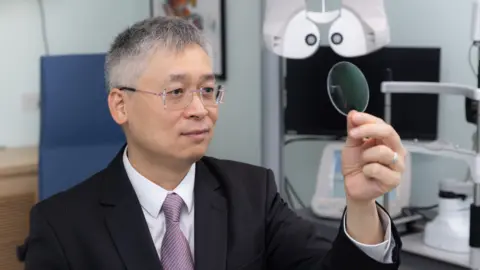 Hong Kong Polytechnic College
Hong Kong Polytechnic CollegeDifferent specs tech is even slowing down the development of eye circumstances akin to myopia, past simply correcting for them.
Prof To has developed glasses lenses which have a honeycomb-like ring in them. Mild passing by way of the centre of the ring, centered as regular, reaches the wearer’s retina and permits them to see clearly.
Nonetheless, gentle passing by way of the ring itself is defocused barely which means that the peripheral retina will get a barely blurred picture.
This seems to gradual improper eyeball development in youngsters, which Prof To says cuts the speed of short-sightedness development by 60%. Glasses with this expertise at the moment are in use in additional than 30 nations, he provides.
British agency SightGlass has a barely totally different strategy – glasses that lightly scale back the distinction of somebody’s imaginative and prescient to equally have an effect on eye development and myopia development.
Whereas autofocus glasses and different high-tech options could have promise, Prof To has an excellent larger aim: glasses that do not simply decelerate myopia however truly reverse it barely – a tantalising prospect that might enhance the imaginative and prescient of doubtless billions of individuals.
“There may be rising proof that you are able to do it,” teases Prof To.
